英美概况第十二讲movies and music
- 格式:ppt
- 大小:13.57 MB
- 文档页数:84
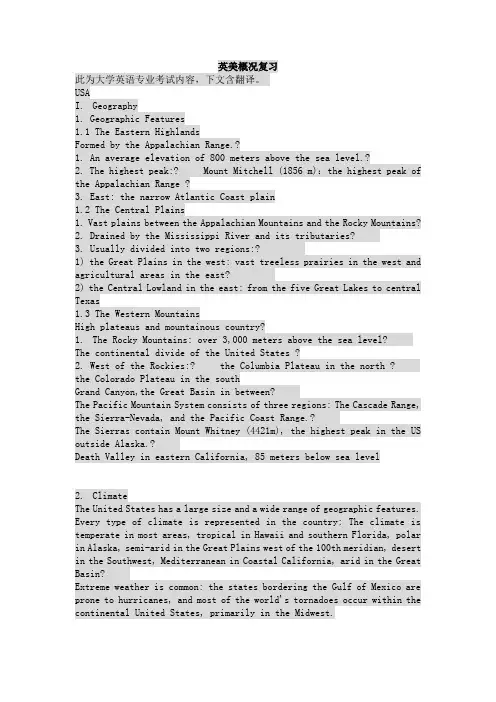
英美概况复习此为大学英语专业考试内容,下文含翻译。
USAI. Geography1. Geographic Features1.1 The Eastern HighlandsFormed by the Appalachian Range.?1. An average elevation of 800 meters above the sea level.?2. The highest peak:? Mount Mitchell (1856 m):the highest peak of the Appalachian Range ?3. East: the narrow Atlantic Coast plain1.2 The Central Plains1. Vast plains between the Appalachian Mountains and the Rocky Mountains?2. Drained by the Mississippi River and its tributaries?3. Usually divided into two regions:?1) the Great Plains in the west: vast treeless prairies in the west and agricultural areas in the east?2) the Central Lowland in the east: from the five Great Lakes to central Texas1.3 The Western MountainsHigh plateaus and mountainous country?1. The Rocky Mountains: over 3,000 meters above the sea level?The continental divide of the United States ?2. West of the Rockies:? the Columbia Plateau in the north ?the Colorado Plateau in the southGrand Canyon,the Great Basin in between?The Pacific Mountain System consists of three regions: The Cascade Range, the Sierra-Nevada, and the Pacific Coast Range.?The Sierras contain Mount Whitney (4421m), the highest peak in the US outside Alaska.?Death Valley in eastern California, 85 meters below sea level2. ClimateThe United States has a large size and a wide range of geographic features. Every type of climate is represented in the country: The climate is temperate in most areas, tropical in Hawaii and southern Florida, polar in Alaska, semi-arid in the Great Plains west of the 100th meridian, desert in the Southwest, Mediterranean in Coastal California, arid in the Great Basin?Extreme weather is common: the states bordering the Gulf of Mexico are prone to hurricanes, and most of the world's tornadoes occur within the continental United States, primarily in the Midwest.3. RiversThe Mississippi River (Great River, Big River in Indian language) is 3,770 km long: the second longest river in the United States. It originates from Minnesota and empties into the Gulf of Mexico.?The Missouri River is 4,090 km long. It is the longest river (longest branch of the Mississippi). It is a Mississippi tributary, flowing from the confluence of the Jefferson, Madison, and Gallatin and emptying into the Mississippi River.The length of the Mississippi-Missouri-Jefferson combination is approximately 6,262 km?The Arkansas River (2,364 km) is the second longest tributary of the Mississippi River. The Ohio River is the largest Mississippi tributary measured by water volume.?The Yukon River is a major watercourse of northwestern North America. Rising in British Columbia, Canada, it runs 3,700 km long, emptying into the Bering Sea.5 great lakesII. American History1. Where did the first Americans come from and why did they migrate to America?Book P 4-52. American Civil warThe American Civil War (1861–1865), also known as the War Between the States, was a civil war in the United States of America. Eleven Southern slave states declared their secession from the U.S. and formed the Confederate States of America (the Confederacy). Led by Jefferson Davis, they fought against the U.S. federal government (the “Union”), which was supported by all the free states and the five border slave states.2.1 The CausesThe coexistence of a slave-owning South with an increasingly anti-slavery North made conflict likely. Lincoln did not propose federal laws against slavery where it already existed, but he had, in his 1858 House Divided Speech, expressed a desire to “arrest the further spread of it, and place it where the public mind shall rest in the belief that it is in the course of ultimate extinction”. Much of the political battle in the 1850s focused on the expansion of slavery into the newly created territories. All of the organized territories were likely to become free-soil states, which increased the Southern movement toward secession. Both North and South assumed that if slavery could not expand it would wither and die.The coexistence of a slave-owning South with an increasingly anti-slaveryNorth made conflict likely. Lincoln did not propose federal laws against slavery where it already existed, but he had, in his 1858 House Divided Speech, expressed a desire to “arrest the further spread of it, and place it where the public mind shall rest in the belief that it is in the course of ultimate extinction”. Much of the political battle in the 1850s focused on the expansion of slavery into the newly created territories. All of the organized territories were likely to become free-soil states, which increased the Southern movement toward secession. Both North and South assumed that if slavery could not expand it would wither and die. Southern fears of losing control of the federal government to antislavery forces, and Northern fears that the slave power already controlled the government, brought the crisis to a head in the late 1850s. Sectional disagreements over the morality of slavery, the scope of democracy and the economic merits of free labor vs. slave plantations caused the Whig and “Know-Nothing” parties to collapse, and new ones to arise (the Free Soil Party in 1848, the Republicans in 1854, the Constitutional Union in 1860). In 1860, the last remaining national political party, the Democratic Party, split along sectional lines.2.2 Factors Affecting the Process and ResultsWhat greatly affected the process as well as the result of the war were the differences between the South and the North in their strategies, geographical features, technology, and manpower and finance.2.2.1 StrategiesAs men poured into the armies, Northern and Southern leaders discussed strategies that would achieve victory.Northern armies would have to invade the Confederacy, destroy its capacity to wage war, and crush the will of the Southern people to resist. The Confederacy could win by prolonging the war to a point where the Northern people would consider the effort too costly in lives and money to persist.The South had a compelling example in the American Revolution of a seemingly weaker power defeating a much stronger one. If the North chose not to mount a military effort to coerce the seceded states back into the Union, the Confederacy would win independence by default.Lincoln and other Northern leaders, however, had no intention of letting the Southern states go without a fight. The most prominent American military figure in the spring of 1861 was Winfield Scott, the general-in-chief of the United States Army. With a brilliant mind, Scott conceived a long-range strategy to bring Northern victory. Scott’s plan sought to apply pressure on the Confederacy from all sides. A combined force of naval and army units would sweep down the Mississippi River, d ividing the Confederacy’s eastern and western states. At the same time, the Union navy would institute a blockade to deny the Confederacy access to European manufactured goods. Should the South continue to resist evenafter the loss of the Mississippi and the closing of its ports, Scott envisioned a major invasion into the heart of the Confederacy.2.2.2 GeographyGeography played a major role in how effectively the two sides were able to carry out their strategies.The sheer size of the Confederacy posed a daunting obstacle to Northern military forces. Totaling more than 1,940,000 km2 and without a well-developed network of roads, the Southern landscape challenged the North’s ability to supply armies that maneuvered at increasing distances from Union bases.It was also almost impossible to make the North’s blockade of Southern ports completely effective because the South’s coastline stretched 5600 km and contained nearly 200 harbors and mouths of navigable rivers.The Appalachian Mountains also hindered rapid movement of Northern forces between the eastern and western areas of the Confederacy while the Shenandoah Valley of Virginia offered a protected route through which Confederate armies could invade the North.The placement of Southern rivers, however, favored the North. The Mississippi, Tennessee, and Cumberland rivers provided excellent north-south avenues of advance for Union armies west of the Appalachians.2.2.3 TechnologyTechnological advances helped both sides deal with the great distances over which the armies fought. The Civil War was the first large conflict that featured railroads and the telegraph. Railroads rapidly moved hundreds of thousands of soldiers and vast quantities of supplies; the North contained almost twice as many miles of railroad lines as the South. Telegraphic communication permitted both governments to coordinate military movements on sprawling geographical fronts.The combatants also took advantage of numerous other recent advances in military technology. The most important was the rifle musket carried by most of the infantrymen on both sides. The rifle musket, with an effective range of 225 to 275 meters, allowed defenders to break up attacks long before they reached the defenders’ positions.Other new technologies included ironclad warships, which were used by both sides; the deployment of manned balloons for aerial reconnaissance on battlefields, used mainly by the North. The technology for all of these weapons had been present before the Civil War, but never before had armies applied the technology so widely.2.2.4 Manpower and FinanceAt the beginning of the war, state militias provided most of the troops for both Union and Confederate armies. Soon large numbers of civilianswere volunteering for military service. Throughout the war, the bulk of the forces consisted of volunteers.When the number of volunteers lagged behind the growing battle casualties, both the Northern and Southern governments resorted to drafting men into the armies. The Confederacy passed the first draft act in April 1862. The Union followed almost a year later.Although the draft itself did not produce a sufficient number of soldiers, the threat of being drafted led many to volunteer and collect a bounty, which was paid to volunteers. Some soldiers were unscrupulous enough to enlist, desert, and reenlist to collect the bounty more than once.The Civil War, like all wars, called for great sums of money to pay troops and supply them with equipment. At the outset of the war the Confederacy depended on loans, but this source of finance soon disappeared as Southerners began to be affected financially by the cost of the war and unable to buy bonds. Instead it relied on paper money, freely printed. The Confederacy suffered greatly from severe inflation and debt throughout the war. The Confederate rate of inflation was about 9200%.The Union financed its armies by loans and taxes to a much greater degree than the Confederacy, even resorting to an income tax. The people of the North were more prosperous than those of the South. A national banking system was established by Congress to stimulate sales of U.S. bonds. Northerners had savings with which they could buy the bonds and had earnings from which taxes could be taken.2.3 The Process2.6.1 Eastern Theater (1861-1863)2.6.3 Western Theater (1861-1863)2.6.4 Trans-Mississippi Theater (1861-1865)3. America in World War IWorld War I, military conflict, from August 1914 to November 1918, that involved many of the countries of Europe as well as the United States and other nations throughout the world.World War I was one of the most violent and destructive wars in European history.Of the 65 million men who were mobilized, more than 10 million were killed and more than 20 million wounded.The term World War I did not come into general use until a second worldwide conflict broke out in 1939. Before that year, the war was known as the Great War or the World War.1.1 Coalitions InvolvedThe war began as a clash between two coalitions of European countries.The first coalition, known as the Allied Powers, included the United Kingdom, France, Belgium, Serbia, Montenegro, and the Russian Empire.The Central Powers, which opposed them, consisted of the empires of Germany and Austria-Hungary.1.2 The Immediate CauseThe immediate cause of the war was the assassination of Archduke Francis Ferdinand, the heir to the throne of Austria-Hungary, by a Serbian nationalist.The fundamental causes of the conflict, however, were rooted deeply in the European history of the previous century, particularly in the political and economic policies that prevailed in Europe after 1871, the year that Germany emerged as a major European power.2. The Great DepressionOn October 24, 1929, the American stock market crashed. Billions of dollars of paper profits were wiped out within a few hours. This led to a long economic depression.However, the post-war industrial boom and the prosperity were soon to vanish. The Great Depression in the United States, worst and longest economic collapse in the history of the modern industrial world, began from the end of 1929 until the early 1940s.2.1 The CausesThe depression was caused by a number of serious weaknesses in the economy.It is a common misconception that the stock market crash of October 1929 was the cause of the Great Depression. The two events were closely related, but both were the results of deep problems in the modern economy that were building up through the “prosperity decade” of the 1920s.As is typical of post-war periods, Americans in the Roaring Twenties turned inward, away from international issues and social concerns and toward greater individualism.The self-centered attitudes of the 1920s seemed to fit nicely with the needs of the economy. Modern industry had the capacity to produce vast quantities of consumer goods, but this created a fundamental problem: Prosperity could continue only if demand was made to grow as rapidly as supply. Accordingly, people had to be persuaded to abandon such traditional values as saving, postponing pleasures and purchases, and buying only what they needed. Advertising methods were used to persuade people to buy such relatively new products as automobiles and such completely new ones as radios and household appliances. The resulting mass consumption kept the economy going through most of the 1920s.But there was an underlying economic problem: Income was distributed very unevenly, and the portion going to the wealthiest Americans grew larger as the decade proceeded. This was due largely to two factors: While businesses showed remarkable gains in productivity during the 1920s, workers got a relatively small share of the wealth this produced. Between 1923 and 1929, manufacturing output per person-hour increased by 32 percent, but workers’ wages grew by only 8 percent. Corporate profits shot up by 65 percent in the same period.As a result of these trends, in 1929 the top 0.1 percent of American families had a total income equal to that of the bottom 42 percent. This meant that many people who were willing to purchase new products did not have enough money to do so. To get around this difficulty, the 1920s produced another innovation—“credit,” an attractive name for consumer debt. People were allowed to “buy now, pay later.”International problems also weakened the economy. After World War I the United States became the world’s chief creditor as European countries struggled to pay war debts and reparations. Many American bankers were not ready for this new role. They lent heavily and unwisely to borrowers in Europe, especially Germany, who would have difficulty repaying the loans, particularly if there was a serious economic downturn. These huge debts made the international banking structure extremely unstable by the late 1920s.In addition, the United States maintained high tariffs on goods imported from other countries, at the same time that it was making foreign loans and trying to export products. This combination could not be sustained: If other nations could not sell their goods in the United States, they could not make enough money to buy American products or repay American loans.The rising incomes of the wealthiest Americans fueled rapid growth in the stock market, especially between 1927 and 1929. Soon the prices of stocks were rising far beyond the worth of the shares of the companies they represented. People were willing to pay inflated prices because they believed the stock prices would continue to rise and they could soon sell their stocks at a profit.In 1928 the Dow Jones industrial average, an index that tracks the stock prices of key industrial companies, doubled in value in less than two years. But the stock boom could not last. The great bull market of the late 1920s was a classic example of a specul ative “bubble” scheme. In the fall of 1929 confidence that prices would keep rising faltered, then failed.Starting in late October the market plummeted as investors began selling stocks. On October 29, known as Black Tuesday, the worst day of the panic, stocks lost $10 billion to $15 billion in value. By mid-November almost all of the gains of the previous two years had been wiped out, withlosses estimated at $30 billion.The stock market crash announced the beginning of the Great Depression.2.3 R oosevelt’s New DealThe initial government response to the Great Depression was ineffective, as President Hoover insisted that the economy was sound and that prosperity would soon return.But business owners saw no reason to increase production while unsold goods clogged their shelves. By 1932 investment had dropped to less than 5 percent of its 1929 level. By the election year of 1932, the depression had made Hoover so unpopular that the election of the Democratic presidential candidate Franklin Delano Roosevelt was all but assured. Shortly after his inauguration in 1933, Roosevelt quickly lifted the nation’s spirits with the rapid and unprecedented actions of the New Deal.The New Deal produced a wide variety of programs to reduce unemployment, assist businesses and agriculture, regulate banking and the stock market, and provide security for the needy, elderly, and disabled. The basic idea of early New Deal programs was to lower the supply of goods to the current, depressed level of consumption. The government sought to raise farm prices by paying farmers not to grow surplus crops and to create codes for many industries that regulated competition while guaranteeing minimum wages and maximum hours for workers. The New Deal also tried to increase demand, pumping large amounts of money into the economy through public works programs and relief measures.Public works projects not only provided jobs but built schools, dams, and roads. The New Deal helped people to survive the depression. Unemployment was reduced, but remained high through the 1930s. Farm income rose from a low of $1.9 billion in 1932 to $4.2 billion in 1940. The demands of the depression led the United States to institute social-security programs and accept labor unions, measures that had been taken decades earlier in many European nations.3.2.1 US and Japanese ConflictIn the final result, however, the United States had little choice in the matter. When France had fallen to Germany, Japan had begun to move into French Indo-China, which had been France's source of rubber and was thought to be rich in oil. The United States government had no desire to see Japan in possession of its own stocks of these essential resources and so threatened to place an embargo on these goods. The Japanese responded in an unexpected way. On Sunday, 7 December 1941, Japanese naval aircraft attacked the U.S. Pacific fleet at anchor at Pearl Harbor in the Hawaiian islands. The Pearl Harbor Attack brought the United States into the war on December 8. Germany and Italy declared war on the United Stateson DecemberThe CongressThe United StatesCongress is the bicameral legislature of the federal government of the United States of America, consisting of two houses, the Senate and the House of Representatives. Both senators and representatives are chosen through direct election.As provided by the United States Constitution, each of the 435 members of the House of Representatives represents a district and serves a two-year term. House seats are apportioned among the states by population. The 100 Senators serve staggered six-year terms. Each state has two senators, regardless of population. Every two years, approximately one-third of the Senate is elected.checks and balances:The government is divided into three branches, the legislative, the executive and the judicial, each has part of the powers but not all the power. And each branch of government can check, or block, the actions of the other branches. The three branches are thus in balance. This called “checks and balances”.What is American General Education?见书English2.1 The Iberians1) They are the earliest settlers on the British Isles.2.2 The Celts1) From 700 B.C. Celts came in several successive waves from the Upper Rhineland and began to inhabit British Isles.2) The fair-haired Celts imposed themselves as an aristocracy on the conquered tribes of Iberians throughout Britain and Ireland.3) These people found refuge in the mountains to the north and west.4) At least two big waves of Celtic invasion can be distinguished: first the Gaels or Goidels, still found in Ireland and Scotland, came over as early as 600 B.C.; secondly the Cymric and Brythons, still found in Wales, come over before 300 B.C.3. Roman Britain3.1 Roman InvasionRoman Britain refers to those parts of the island of Great Britain controlled by the Roman Empire between AD 43 and 410.The Romans referred to their province as Britannia.Prior to the Roman invasion, Iron Age Britain already had cultural and economic links with Continental Europe, but the invaders introduced new developments in agriculture, urbanization, industry and architecture, leaving a legacy that is still apparent today.It is believed that the Celts were related with the ancient people in what is now France. They gave some help in the struggle to resist the Roman invasion of France. As a result, the Roman army, commanded by Julius Caesar, invaded England in 55 BC. He landed in Kent with several thousand Roman troops, but meeting resistance and bad weather, the Roman withdrew soon after. In the following year, Julius Caesar and the Romans went across the English Channel and invaded Britain for the second time. Julius Caesar and his soldiers did not stay long in England before they withdrew again. The invasion marked the beginning of English recorded history because Julius Caesar kept a diary and wrote down what he saw in England. The successful invasion of England by the Romans did not take place until nearly a century later, in 43 AD, headed by the Emperor Claudius I. The Romans did not meet with much resistance on the part of the natives and soon got possession of what is now England by driving many of the native Celts into mountainous Scotland and Wales. The Romans failed to conquer Scotland, they built two great walls, the Hadrian’s Wall and the Antonine Wall, along the northern border of England to prevent the Picts in Scotland from invading England.3.2 Influences of Roman InvasionThe 3d and 4th centuries witnessed the decline of the Roman Empire. In 410 Rome abandoned Britain.1. Roman urban civilization, baths and amphitheaters, as well Hadrian’s Wall. People who spoke Latin and wore togas. Numerous villas——vast estates worked by slaves and featuring sumptuous noble dwellings—were also established. Beyond these, the countryside remained Celtic.2. A network of roads, still in use for 1400 years;3. A number of towns. They introduced a system of organized government and built a network of towns, mostly walled. These town used names ending with “ster”, “cester”, or “shire” -- Leicester, Worcester and Yorkshire—deriving from castra, the Latin word for camp; the Roman capital was London.4. Christianity; the Romans brought the new religion, Christianity, to Britain. This came at first by indirect means, probably brought by traders and soldiers, before the first Christian Emperor, Constantine, we proclaimed in 306 AD.5. Water and sewage systems.1.1 Anglo-SaxonSoon after the Romans left, a band of new invaders landed in the southern part of England, in what is now the country of Kent. They were known in history as the Jutes. Other Germanic tribes came trooping after them. This continued for many years. The Saxons came from northern Germany and established their kingdoms in Essex (East Saxow), Succes (South Saxon) and Wessex (West Saxon). In the second half of the 6th century, the Angles, also from northern Germans, came and settled in the east part of England. After the newcomers had taken possession of all the land now known as England, the movement, know in history as the Anglo-Saxon Conquest, was complete. But we must bear in mind that theses Germanic tribes never obtained possession of what we now call Scotland, Wales and Ireland. The inhabitants of these countries were still Celts.The England was divided into seven principal kingdoms, known as Heptarchy in English history: Northumbria, Mercia, Kent, East Anglia, Essex, Sussex and Wessex were the main polities of south Britain.The influence of Anglo-Saxon?The Anglo-Saxons laid the foundations of the English state. They divided the country into shires, with shire courts and shire reeves, or sheriffs, responsible for administering law.?They devised the narrow-strip, three-field farming system which continued to the 18th century. In this system, the arable land around a village was divided into three hedgeless (open) big fields. These fields were divided into narrow strips which were shared out among the villagers. Good land was thus fairly distributed. One great field was left “fallow” each year so that its soil could recover its richness after two years’ cultivation.?They set up the basis of the English agrarian civilization and subsistence farming. There were wastelands, known as commons, which were used by villagers to graze livestock and get firewood. This system was the basis of the English agrarian civilization and subsistence farming. It helped to shape the English community life and the Anglo-Saxon concept of equality.?They created the Witan(council or meeting of the wisemen) to advise the king, the basis of the Privy Council which still exists today.2. Viking Invasion (800–1066)In the 8th century, the Vikings from theScandinavian countries of northern Europe, Norway and Denmark, began to attack the English coast. In the process of resisting the Vikings, the 7 Anglo-Saxon kingdoms in England gradually became united under Alfred the Great.Alfred was a king of Wessex. He was not only an able warrior but also adedicated scholar and a wise ruler. He defeated the Danes and reached a friendly agreement with them in 879. The Danes gained control of the north and east, while he ruled the rest. He also converted some leading Danes into Christians.He founded a strong fleet and is known as “ the father of the British navy”. He reorganized the Saxon army, making it more efficient. He translated a Latin book into English. He also established schools and formulated a legal system.After the death of Alfred, his successors were not as capable as he had been. Taking advantage of the situation, more Dane came and set about taking possession of the entire country. The Anglo-Saxon king didn’t care for fighting, but he dreamed of buying off the Danes. As a result, more invaders came. In 1016, the Witan chose Canute, the Danish leader, as king of England. Canute, who made England part of a Scandinavian empire which included Norway as well as Denmark.3. Norman Conquest3.1 Norman Conquest: CauseAfter the death of Canute’s son, the crown was passed to Edward the Confessor, the last Anglo-Saxon king.When Edward was on his death-bed, several men laid claim to the English throne, the king of Norway, the Duke of Normandy (Edward’s cousi n), and Harold Godwinson( a brother of Edward’s wife).William, the Duke of Normandy, claimed the Edward had promised the crown to him before his death. He became very angry when he heard that Harold had taken the crown. Harold knew that William would come to measure swords with him. he was prepared to fight, placing an army on the southern coast of England to watch for William’s coming. Several months passed by and William failed to appear. He was abiding his time. When the harvest time in England came, ma ny of Harold’s soliders went back home to gather in the crops/. The coast was thus left undefended.William seized the chance and landed his army in Southeastern England in Sep. 1066. Harold, who had been fighting in the north, hurried back with the exhausted troops. They fought at the Battle of Hastings on 14 October. It was a close battle at first, but in the final hours William’s superiority in cavalry and archers proved decisive. Harold was killed, along with his brothers Earl Gyrth and Earl Leofwine, and the English army fled.William became known as William the Conqueror, the first Anglo-Norman king of England.3.2 Control of EnglandAfter Willam became the king, he took a few measures to control England Soldiers rewarded: The Normans received from William lands and titles in return for their service in the invasion.All land was the king’s: William claimed ultimate possession of。

![英美概况笔记(中英文对照整理版)[1]](https://uimg.taocdn.com/564c646bf342336c1eb91a37f111f18583d00c2d.webp)
英美国家概论路人整理2011-7-27目录第一章英国的国土与人民LAND AND PEOPLE (3)第二章英国的起源THE ORIGINS OF A NATION (9)第三章英国的形成THE SHAPING OF THE NATION (16)第四章向现代英国的过渡TRANSITION TO THE MODERN AGE (22)第五章大英帝国的兴衰THE RISE AND FALL OF THE BRITISH EMPIRE (28)第六章英国经济THE ECONOMY (40)第八章法律与司法机构JUSTICE AND THE LAW (49)第九章英国社会SOCIAL AFFAIRS (55)第十章体育运动SPORTS (60)第十三章美国地理位置GEOGRAPHY (66)第十四章美国人口种族POPULATION.RACE AND ETHNIC GROUPS (70)第十五章美国历史(一)AMERICAN HISTORY(I) (73)第十六章美国历史(二)AMERICAN HISTORY(II) (77)第十七章美国历史(三)AMERICAN HISTORY(III) (81)第十八章美国经济THE ECONOMY (84)第十九章政治制度POLITICAL INSTITUTION (88)第二十章美国教育EDUCATION (93)第二十一章文化建筑和音乐LITERATURE, ARCHITECTURE AND MUSIC (98)第二十二章节日和假期HOLIDAYS AND FESTIVALS (102)第二十二章节:HOLIDAYS AND FESTIVALS 节日和假期 (102)第一章英国的国土与人民Land and PeopleI. Different Names for Britain and its Parts英国的不同名称及其各组成部分1.Geographical names: the British Isles, Great Britain and England.地理名称:不列颠群岛,大不列颠和英格兰。
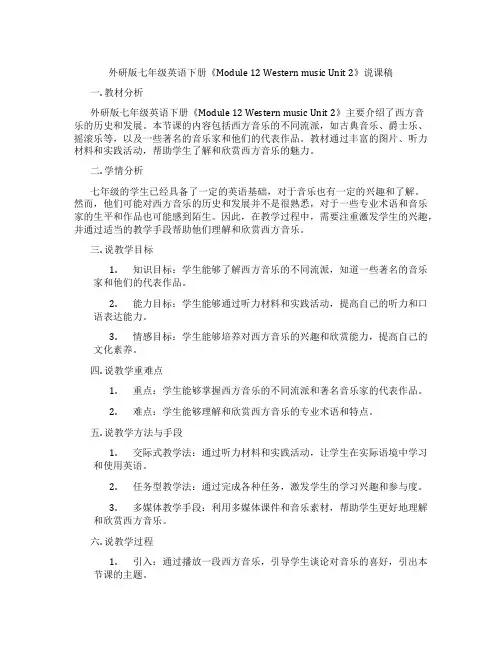
外研版七年级英语下册《Module 12 Western music Unit 2》说课稿一. 教材分析外研版七年级英语下册《Module 12 Western music Unit 2》主要介绍了西方音乐的历史和发展。
本节课的内容包括西方音乐的不同流派,如古典音乐、爵士乐、摇滚乐等,以及一些著名的音乐家和他们的代表作品。
教材通过丰富的图片、听力材料和实践活动,帮助学生了解和欣赏西方音乐的魅力。
二. 学情分析七年级的学生已经具备了一定的英语基础,对于音乐也有一定的兴趣和了解。
然而,他们可能对西方音乐的历史和发展并不是很熟悉,对于一些专业术语和音乐家的生平和作品也可能感到陌生。
因此,在教学过程中,需要注重激发学生的兴趣,并通过适当的教学手段帮助他们理解和欣赏西方音乐。
三. 说教学目标1.知识目标:学生能够了解西方音乐的不同流派,知道一些著名的音乐家和他们的代表作品。
2.能力目标:学生能够通过听力材料和实践活动,提高自己的听力和口语表达能力。
3.情感目标:学生能够培养对西方音乐的兴趣和欣赏能力,提高自己的文化素养。
四. 说教学重难点1.重点:学生能够掌握西方音乐的不同流派和著名音乐家的代表作品。
2.难点:学生能够理解和欣赏西方音乐的专业术语和特点。
五. 说教学方法与手段1.交际式教学法:通过听力材料和实践活动,让学生在实际语境中学习和使用英语。
2.任务型教学法:通过完成各种任务,激发学生的学习兴趣和参与度。
3.多媒体教学手段:利用多媒体课件和音乐素材,帮助学生更好地理解和欣赏西方音乐。
六. 说教学过程1.引入:通过播放一段西方音乐,引导学生谈论对音乐的喜好,引出本节课的主题。
2.讲解:通过多媒体课件,介绍西方音乐的不同流派和著名音乐家的代表作品。
3.听力练习:让学生听一段西方音乐,并回答相关问题,提高学生的听力能力。
4.实践活动:学生分组讨论,选择一位著名音乐家,介绍他的生平和作品,并展示给其他同学。
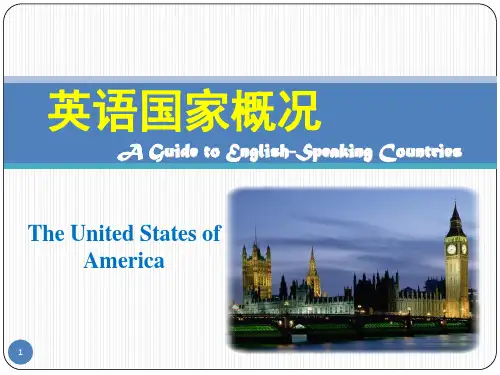

Unit 12The Industrial Revolution and the Formation of the British EmpireAfter the period of the Civil War and the Revolution in the second half of the seventeenth century, Britain entered a new period. The centre of interest in the kingdom was shifted from the internal political struggle to the economic problems and foreign expansion. As the result, the economic development gave rise to the British Industrial Revolution in the last part of the 18th century and foreign expiation gave rise to the British Empire at the end of the nineteenth century.The Development of Britain after the RevolutionsThe Struggle with France1.William III faced dangers. The wild highlanders rose for James and onlywhen they were defeated Scotland accepted William and Mary and the two countries were linked by the Crown2.In July 1690 and English and Dutch army led by William met an Irish andFrench army under James on the banks of River Boyne. It was this victory that saved the English Revolution and Europe from French domination. 3.It was the Battle of La Hogue in May 1692, the great naval victory thatfreed England from the threat of French invasion. The peace made in 1697 was inconclusive, but there were two important consequences of the war.One was the foundation of the Bank of England and the financing of the struggle by loans; the other was an arrangement that was soon to lead to the Cabinet system.4.In 1702, John Churchill destroyed Louis XVI’s army in the War of theSpanish Succession.5.In 1704, he won the victory at Ramilies and drove the French out ofNetherlands.6.In 1707, Act of Union was negotiated. The two Parliaments were united andthe island became Great Britain with the symbolic flag, the Union Jack. 7.In 1713, the Treaty of Utrecht was signed. Britain retained many coloniesfrom France.House of HanoverQueen Anne died in 1714and the crown passed to her cousin George, the Elector of Hanover and thus in England began the Hanoverian rule. The elderly German could speak no English and understood little about English politics. As the result, the Cabinet system of government was gradually established.The succession of Hanover had an important effect on both foreign and domestic policies of the country. Monarch reigned by act of Parliamentinstead of on advice of Parliament. The substitution of Hanover for Stuart implied a completely different set of European connections. Britain’s interest was to pass from the Netherlands to Hanover, and the electorate remained link to the British crown until 1837.The Hanoverian succession also marked very distinctly a new era in the working of the British constitution and Parliamentary politics.The Seven Years’ WarIn the middle of the 18th century, the conflict between France and England in the colonies resulted in the Seven Years’ War, l asting from 1756 to 1763. The War was carried on mainly in India and America. The war was ended by the Peace of Paris in 1763.By the Peace of Paris France ceded all Canada and her American possession west to the 13 colonies to Britain, while in India the French were reduced to two small trading stations and agreed to acknowledge the East India Company’s complete control over the native rulers of the huge provinces: France gave up four of her West Indian islands, as well as her African possessions.Loss of the American ColoniesThe Industrial RevolutionBackground to the Industrial Revolution1.The constitutional monarchy created a good condition for the development of capitalist economy.2.The Enclosures supplied sufficient labourers for the large scale development of capitalist industries.3.The English bourgeoisie had accumulated a large sum of money and completed its “primitive accumulation of capital”.4.The rapid development of handicraft industry laid the necessary foundation of material and technology for machine production.5.The English ideology had also experienced changes.1/ Renaissance2/ the importance of money3/ Francis Bacon4/ Isaac Newton5/ Adam Smith’s the Wealth of NationsProcess pf the Industrial RevolutionThe Industrial Revolution in Britain first started in the textile industry.The spinning Jenny: in 1764, by James Hargreaves2. The spinning machine: in 1769, by Richard Arkwright3. The spinning mule: in 1779, by Samuel Crompton4. The power loom: in 1785, by Edmund Cartwright5. The steam engine: in 1769, by James Watt6. The steam locomotive: in 1814, by StephenConsequences of the Industrial Revolution1.Britain became the “workshop of the world” and could produce largequantity of low-priced goods in a more efficient manner. So no country was strong enough to compete with her in foreign trade.2.The social class structure in Britain got simplified. The middle class waspushed to the dominant position and the large majority was turning to the proletariat. So the class struggle between the bourgeoisie and the proletariat occupied the dominant position in England.3.The economic centre and sources of nation’s wealth in Britain also shiftedfrom South to Central and North England, from farms to towns, and from agriculture to industry.4.The country was splitting into two nations of owners and workers, rich andpoor.5.With the establishment of capitalist production and introduction of farmmachines came the agricultural revolution.6.The Industrial revolution also led to social and political movements such astrade unionism and Chartism.So it was not only a technological revolution but also a great social upheaval. Itexerted a great influence on both British society and the world.Political ReformConditions before the ReformUnemployed workers increased and population was multiplying.A new Corn Law passed by the Parliament to keep the corn price up. Conditions were made even worse by the flow of poor workers from Ireland. Strikes commonly happened hand mass meetings were frequently held in many cities, collimating in the “Peterloo Massacre”.Meanwhile both social and political reforms were taking place. Robber Peel created the first efficient police force. And in 1829, the Catholic Emancipation Act was passed.Parliamentary ReformIn 1830, Lord Grey’s Whig government introduced a measure of parliamentary reform. The new Whig government drew up a bill that abolished the rotten boroughs and gave their seats to new towns.In June 1832, it was eventually passed with the support of working class.The industrial and commercial classes won the victory, while the working class who had contributed much got nothing in return.The Chartist MovementBackgroundSince the beginning of the Industrial Revolution, the British proletariat had encouraged struggles in different forms to destroy machines and to organize trade unions to struggle for wages and better working conditions.The working class infuriated by unjust treatment and the inhumanity of the Poor Law, had lost faith in the Whigs and their middle class allies. Most of them realized that only by depending on their own strength they could improve social conditions in their favour. Thus they began to act as an independent class and put forward their own demands.ProcessContents: I n 1837, the London Working Association worked out the People’s Charter: universal suffrage; adoption of equal electoral districts; abolition of the property qualifications for Members of Parliament; payment of MPs; secret voting; and annual election of Parliament.Process:1. The charter was formally adopted at a meeting of workers held on August 8, 1838 on Newhall Hill. The elected Convention presented the Charter to the Parliament in the form of a petition in January 1839. It was rejected it in July.2. The second stage began in 1840. A National Charter Association was founded. In 1842 it was presented to the Parliament for the second time. But it wasrejected again.3. In 1848the Chartist Movement experienced its third and last upsurge. The procession was abandoned. After this third failure, the Chartist Moment declined and soon ended.Significance and LessonsThough the Chartist Movement failed, it had opened a new chapter for the history of the working class movement and constituted a glorious page in the history of the worker’s struggle for liberation.The Movement also afforded useful lessons for the political struggle in future of the working class. The lessons were: the leadership was rather weak; the working class was not mature yet and small disagreements might cause disintegration; what was more important, the English bourgeoisie then was not a dying, but a rising class and was still on the rise.Victoria and Her TimeQueen VictoriaVictoria became the queen in 1837 and she ruled the British Empire for sixty years and was another well-known Queen in English history.Victoria’s AgeVictoria’s age was an age of national development and national optimism inBritain, with only occasional doubts about the future.It was full of tremendous changes in almost every respect.In 1859, Origin of Species by Charles Darwin was published in which he put forward a new theory about survival of the fittest in natural world.The change in outlook was a great help to the growth of a grouped famous writers.The improved social condition helped to give the birth of the Fabian Society in 1884, which advocated the English type of “socialism” based on class co-operation.Britain’s social changes at home were the cause and effect of its foreign expansion during the same time.Victoria also established the family virtues by her personality and her influence in life, which set a standard for the English middle class for many years to come.The Rise of the British EmpireColonial ExpansionThe British colonial expansion mainly went through two processes: aggression with a sovereign state and annexation with uninhabited or sparsely populated wild lands.The cases with countries such as India and China belonged to the firstcategory.* Indian Mutiny: in 1857* Opium WarThe English aggression in some places in America and Oceania belonged to the second category.* In 1607, the first permanent colony Jamestown was established and in 1624 the Crown took it over as a royal colony.* In 1766 England established its local government in Canada and later it also gave the colony right of self-government.* As for Australia and New Zealand, the English began colonization there in 1787. A few years later, the colonies in Australia were given internal self-government. In 1900 the commonwealth of Australia was established. New Zealand was annexed by Britain in 1840 and the dominion of New Zealand was established later.In Africa, 1/ the English established their control in Nigeria, Gold Coast, Kenya and Uganda. 2/ In 1857, British government bought a controlling share in the Suez Canal. 3/ the Cape Colony was wrested during the wars from Napoleon, where the Dutch (Boers) lived. 4/ in 1899, the Anglo-Boer War broke out and Britain defeated Boers, and established the South Africa colony. 5/ in the north and northeast, Britain occupied Egypt (1882), Sudan in 1898, Somaliland in 1887. By the beginning of the 20th century, Britain occupied one-third of the whole Africa.In Latin America, Britain also occupied many places, especially in Central America, such as Guiana and Dominica. In addition, there were countless islands and islets in the Pacific and Atlantic Oceans which were controlled or claimed by the British government.The Sun-Never-Setting EmpireBy the end of the 19th century Britain had reached the peak of its colonial expansion, and she kept expanding. It had colonies all over the five continents.British ImperialismThe typical capitalist of Britain was now no longer a factory owner running his own business and making efforts to develop industry, but a shareholder drawing dividend from the investment of a vast capital.The features of imperialism:1.the export of capital2.the territorial expansion3.monopolyBy 1900 Britain already revealed at least two important features above mentioned; therefore, Britain had been transformed from capitalism into imperialism.11。

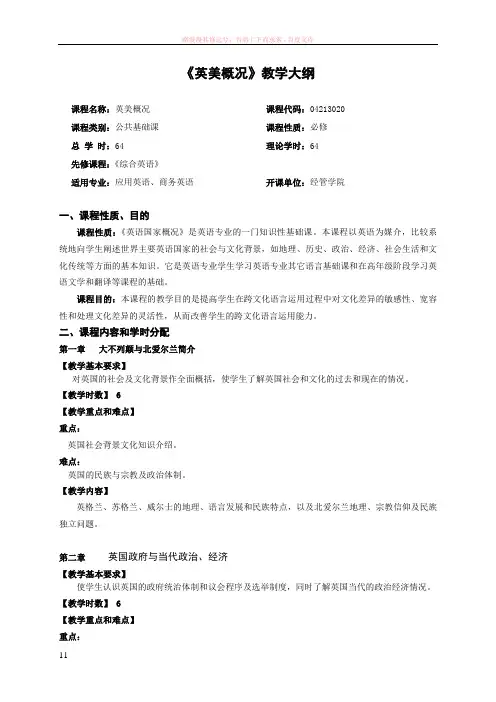
《英美概况》教学大纲课程名称:英美概况课程代码:04213020课程类别:公共基础课课程性质:必修总学时:64 理论学时:64先修课程:《综合英语》适用专业:应用英语、商务英语开课单位:经管学院一、课程性质、目的课程性质:《英语国家概况》是英语专业的一门知识性基础课。
本课程以英语为媒介,比较系统地向学生阐述世界主要英语国家的社会与文化背景,如地理、历史、政治、经济、社会生活和文化传统等方面的基本知识。
它是英语专业学生学习英语专业其它语言基础课和在高年级阶段学习英语文学和翻译等课程的基础。
课程目的:本课程的教学目的是提高学生在跨文化语言运用过程中对文化差异的敏感性、宽容性和处理文化差异的灵活性,从而改善学生的跨文化语言运用能力。
二、课程内容和学时分配第一章大不列颠与北爱尔兰简介【教学基本要求】对英国的社会及文化背景作全面概括,使学生了解英国社会和文化的过去和现在的情况。
【教学时数】 6【教学重点和难点】重点:英国社会背景文化知识介绍。
难点:英国的民族与宗教及政治体制。
【教学内容】英格兰、苏格兰、威尔士的地理、语言发展和民族特点,以及北爱尔兰地理、宗教信仰及民族独立问题。
第二章英国政府与当代政治、经济【教学基本要求】使学生认识英国的政府统治体制和议会程序及选举制度,同时了解英国当代的政治经济情况。
【教学时数】 6【教学重点和难点】重点:英国政府体制的特色;民族等级制度对人民生活的影响;英国经济发展的原因。
难点:英国政府议会选举程序。
【教学内容】1、英国君主立宪制度议会制度及内阁2、英国选举制度、政党制及政治发展趋势3、英国经济概况、农业及飞机工业的发展第三章英国的对外关系【教学基本要求】通过课文讲解使学生认识英国的发展历史、外交政策及英美两国的关系。
【教学时数】6【教学重点和难点】重点:英帝国的扩张历史;难点:对外政策的基础和对外关系发展。
【教学内容】1、大英帝国的扩张历史及现状、英国对外政策的基础和立足点2、英国与北约、欧盟等一些国际组织的关系3、英美两个资本主义大国之间的关系第四章英国社会文化与生活【教学基本要求】通过教学,让学生了解英国的教育体制和社会各阶层的生活情况。
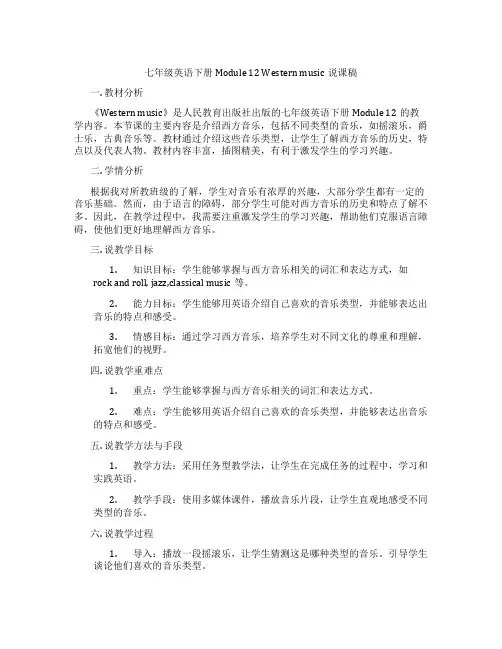
七年级英语下册 Module 12 Western music说课稿一. 教材分析《Western music》是人民教育出版社出版的七年级英语下册Module 12的教学内容。
本节课的主要内容是介绍西方音乐,包括不同类型的音乐,如摇滚乐,爵士乐,古典音乐等。
教材通过介绍这些音乐类型,让学生了解西方音乐的历史,特点以及代表人物。
教材内容丰富,插图精美,有利于激发学生的学习兴趣。
二. 学情分析根据我对所教班级的了解,学生对音乐有浓厚的兴趣,大部分学生都有一定的音乐基础。
然而,由于语言的障碍,部分学生可能对西方音乐的历史和特点了解不多。
因此,在教学过程中,我需要注重激发学生的学习兴趣,帮助他们克服语言障碍,使他们更好地理解西方音乐。
三. 说教学目标1.知识目标:学生能够掌握与西方音乐相关的词汇和表达方式,如rock and roll, jazz,classical music等。
2.能力目标:学生能够用英语介绍自己喜欢的音乐类型,并能够表达出音乐的特点和感受。
3.情感目标:通过学习西方音乐,培养学生对不同文化的尊重和理解,拓宽他们的视野。
四. 说教学重难点1.重点:学生能够掌握与西方音乐相关的词汇和表达方式。
2.难点:学生能够用英语介绍自己喜欢的音乐类型,并能够表达出音乐的特点和感受。
五. 说教学方法与手段1.教学方法:采用任务型教学法,让学生在完成任务的过程中,学习和实践英语。
2.教学手段:使用多媒体课件,播放音乐片段,让学生直观地感受不同类型的音乐。
六. 说教学过程1.导入:播放一段摇滚乐,让学生猜测这是哪种类型的音乐。
引导学生谈论他们喜欢的音乐类型。
2.新课呈现:介绍摇滚乐,爵士乐和古典音乐。
通过图片和音乐片段,让学生了解这些音乐的特点。
3.课堂活动:学生分成小组,选择一种音乐类型,用英语介绍这种音乐的历史,特点和代表人物。
4.实践环节:学生自己动手,创作一段音乐,并尝试用英语表达出来。
5.总结:教师引导学生总结本节课所学的内容,并鼓励他们分享自己的学习心得。

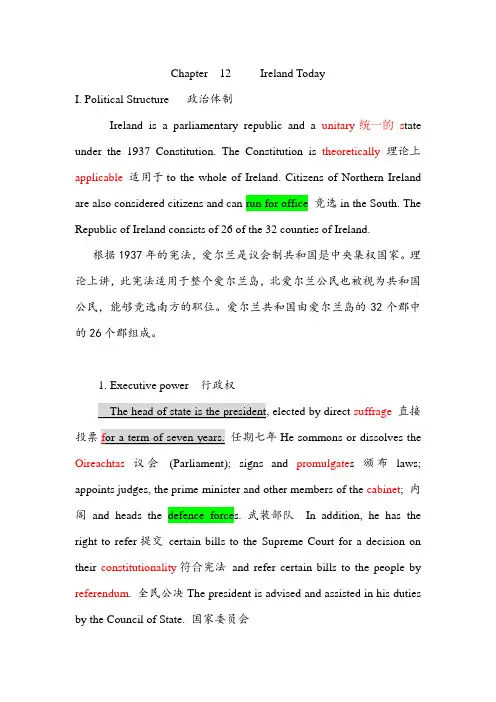
Chapter 12 Ireland TodayI. Political Structure 政治体制Ireland is a parliamentary republic and a unitary统一的s tate under the 1937 Constitution. The Constitution is theoretically 理论上applicable适用于to the whole of Ireland. Citizens of Northern Ireland are also considered citizens and can run for office 竞选in the South. The Republic of Ireland consists of 26 of the 32 counties of Ireland.根据1937年的宪法,爱尔兰是议会制共和国是中央集权国家。
理论上讲,此宪法适用于整个爱尔兰岛,北爱尔兰公民也被视为共和国公民,能够竞选南方的职位。
爱尔兰共和国由爱尔兰岛的32个郡中的26个郡组成。
1. Executive power 行政权suffrage 直接投票任期七年He sommons or dissolves the Oireachtas议会(Parliament); signs and promulgate s 颁布laws; appoints judges, the prime minister and other members of the cabinet;内阁and heads the defence forces.武装部队In addition, he has the right to refer提交certain bills to the Supreme Court for a decision on their constitutionality符合宪法and refer certain bills to the people by referendum. 全民公决The president is advised and assisted in his duties by the Council of State.国家委员会他召集或解散议会;签署和颁布法律;任命法官、首相和其他内阁成员;统率武装部队。
英美概况知识点Part 1.英国的全称为:The United Kingdom of Great Britain and Northern Ireland,这就是英国的英文全称,有时候也可以称:The United Kingdom。
一.英国四部分是英格兰(England),首都伦敦(London),英格兰是英国面积最大、人口最多、经济最发达的一个部分。
(England is the largest, most populous and most economically developed part of Britain.)苏格兰(Scotland),首都爱丁堡(Edingburgh)威尔士(Wales),首都卡迪夫(Cadiff)北爱尔兰(Northern Ireland)、首都贝尔法斯特(Belfast)。
英国人凯尔特人(凯尔特人)作为英国本土人。
凯尔特部落从公元前750年左右从欧洲穿越而来。
C、凯尔特部落的盖尔人主要定居在北方(现代苏格兰人和爱尔兰人的祖先)。
凯尔特人的英国人。
部落(现代威尔士人的祖先),生活在原始社会。
Celts(凯尔特人)taken_as the nativeșin Britain. The Celtic tribes crossed from Europe from about 750B. C. the Gaels of the Celtic tribes mainly settled in the north (the modern Scottish and Irish's ancestors). the Britons of the Celtic . tribes(the modern Welsh's ancestors ),living in primitivesociety.盎格鲁撒克逊人英国人的祖先。
盎格鲁人、撒克逊人和朱特人属于日耳曼部落,大约在5世纪来到英国。
Blues refers to a type of slow, sad music from the southern US, from the cit of New Orleans. The Blues is derived from a blend of field chantey and spiritual--- a form of hymn singing prevalent in African-American Christian churches. The tradition of the vocal ballad usually accompanied by a guitar, it also contributed to the blues form. The music of the blues has a peculiar sadness. The lyrics of the blues pieces are sardonic filled with wry, self-deprecating humor.Super Bowl is the final match of professional American Football competition, which decides the champion team for the year.Yellowstone National Park is the oldest and one of the largest national parks in the US. It is named after the Yellowstone River that flows through the area. It is known for its geysers and hot springs among other natural wonders.Montgomery bus boycott In December 1955, Rosa Parks, a NAACP member in Montgomery Alabama, refused to give up her seat to a white man on a public bus. Mrs. Parks was arrested. Local blacks leaders decided to boycott the city’s bus system refusing to ride on public buses. With the aid of a 1956 Supreme Court decision, Montgomery blacks triumphed. The boycott was believed to be the beginning of the Civil Rights Movement of the1960s.Counterculture In the wake of the Free Speech Movement and the New Left, there appeared a counterculture movement which rejected capitalism other American principles.Affirmative Action Programs were first advocated b some colleges in the 1960. The purpose of the programs was to equalize educational opportunities for all groups and to make up for past inequality by giving special preference to members of minorities seeking jobs or admission to college.Three Faiths in the US American were considered to come in three basic varieties: Protestant, Catholic and Jewish.The Bill of Rights consists of the first 10 amendments which were added to the Constitution in 1791, which guarantees freedom and individual rights such as freedom of speech, the right to assemble in public places, the right to own weapons and so on.Puritanism Puritans were those who followed the doctrine of John Calvin and wanted to purify the Church of England. They believe that human beings were predestined by God before they were born. Some were God’s chosen people while others were damned to hell. No church nr good works could save people. The sign of being God’s select was the success in his work or the prosperity in his calling. They also argued that everyone must read the Bible in order to find God’s will and establish a direct contact with God. These beliefs had great impact on American culture. Benjamin Franklin was one of the founding fathers of the United States of America. He participated in writing the Declaration of Independence and making the US constitution.The Bill of Right of 1689 In 1688, King James II’s daughter Mar and her husband William were invited b the politicians and church authorities to take the throne, on condition that they would respect the rights of Parliament. The Bill of Rights was passed in 1689 to ensure that the King would never be able to ignore Parliament.The Commonwealth In the author’s opinion, the Commonwealth is a voluntary association of states which is made up of former British colonies. There are 50 members of the Commonwealth: many of these are developing counties like India and Cyprus; others are developed nations like Australia, Canada and New Zealand. The Commonwealth was set up as a forum for continued cooperation and as a sort of support network.The Times began publishing in 1785 and it is the United Kingdom’s oldest daily newspaper.The three traditions of Christmas in Britain One is the Christmas Pantomime, a comical musical play. The main male character is played by a young woman while the main female character, often an ugly woman called “The Dame”, is played by a man. Another British Christmas tradition is to hear the Queen give her Christmas message to her realm over the television and radio. A third British tradition is Boxing Day, which falls on the day after Christmas. Traditionally, it was on Boxing Day that people gave Christmas gifts or money to their staff or servants. Now that most British people do not have servant, this custom is no loner observed. However, a new Boxing Day custom has emerged, in the cities: shopping. Shops open up to sell off all their Christmas stock decorations, food, cards, and gift items at low prices.George Washington was one of the founding fathers of the American Public. He was the Commander-in- Chief of the Continental Army in the War of Independence against the British colonial rule and the first president of the United States.Martin Luther King. Jr. A black Baptist minister, he was the leader of the Southern Christian Leadership Conference during the civil rights movement of the 1960s. To promote his philosophy of nonviolent protest against segregation and other kinds of social injustice, King organized a series of “marches”, including the march on Washington of August, 1963, when King delivered his famous “I have a dream”speech. As a civil rights leader, King worked not only to end racial discrimination and poverty, but also to raise the self images of the Blacks. Due to his strong belief in non-violent peaceful protest, King was awarded the Nobel Peace Prize in 1964. he was assassinated in the city of Memphis in April 1968.The Protestant Reformationa.It was a religious reform movement that started in 1517, when the German monk MartinLuther posted for debate a series of theses that challenged Roman Catholic teaching.b.Those who separated themselves from Catholic Church were called Protestants.c.Most of the Protestants stress the Bible as the source and the norm of teaching instead of thePope as the source of authority.The separation of powers Influenced by Montesquieu’s theory of division of powers, the US constitution ruled that political power between legislature, executive, and judicial authorities, and that these authorities should exercise checks against each other.Child-centered culturea.Americans are so devoted and permissive toward their children that they create achild-centered culture.b.The ambitions of parents are more often related to their children’s lives than to their own.c.American parents try to give their youngsters many opportunities to develop skills andworthwhile interests.d.During the summer, parents try to give their children other kinds of learning experiencesthrough camping or travel.The Glorious Revolutiona.It refers to the event of 1688 in the English revolution, when the Catholic King James II wasforced to flee with his baby son to France.b.The throne was offered to his protestant daughter and her husband Dutch king Williamc.The Bill of Rights was passed by Parliament to restrict the power of the monarchy.d.This was the beginning of the Constitutional Monarchy in Britain.The Ku Klux Klana.After the civil war, some southern whites formed the Ku Klux Klan.b.It was a violent secret society that hoped to protect white interests and advantages byterrorizing blacks and prevent them from making social advances.c.By 1872, the federal government had suppressed the Klan, but it revived several times in laterhistory.Progressive Movementa.It was a movement in early 20th century to reform society and individuals through governmentaction.b.It was primarily a movement of social engineers who believed that scientific and cost-efficientsolutions could be found to all political problems.Pioneering Spirita.In the middle-nineteenth century, it was this pioneering spirit that led American settlers totravel westward by the thousands in search of land and gold.b.It is still an important part of the American character.c.Today, northerners and Midwesterners are attracted to the west because of good businessopportunities and mild climate.The British Constitution Britain has no written Constitution. The foundations of the British state are laid out in statute law, which are laws passed by parliament; the common law, which are laws established through common practice in the courts, and conventions.The House of Common is the real centre of British political life because it is the place where about 650 elected representatives (members of Parliament) make and debate policy. These MPs are elected in the General election and should represent the interests of the people who vote for them. WASP stands for “white Anglo-Saxon protestant”, the main stream culture of the U.S..The Pilgrimsa.In England, there had been a group of people called Puritans who had broken away from theChurch of England and formed their own churches. Later they fled to Holland to escape the persecution in their native land.b.Several years passed when they were again threatened by religious suppression, they thoughtof moving, and this time to America.c.They began to call them Pilgrims because of their wanderings in search of religious freedom.d.In 1620, they crossed the Atlantic in the ship Mayflower and settled at Plymouth,Massachusetts.Boston Tea Partya.In the years following the French and Indian War, British government enforced several actswhich were bitterly opposed b colonists.b.In order to ease tensions, British government removed all the new taxes except that one tea.c.In 1773, a group of patriots responded to the tea tax b staging the Boston Tea Party. Disguisedas Indians, the boarded British merchant ships and tossed 342 crates of tea into Boston harbor.d.British parliament then passed the “intolerable Acts”, and in response to this, the firstContinental Congress was held in September 1774.Oliver Cromwell was the Roundhead leader during the English Civil War. He defeated King Charles and condemned him to death. The monarchy was overthrown, and the country became for more than ten years a republic.Indentured Servants They were free Englishman who contracted to work without pay for severalyears in return for their passage to America. Most of them worked in southern tobacco and rice plantations.Plymouth Colony It was the second English settlement in America. It was the Pilgrims who settled Plymouth Colony. Plymouth Harbor had once been an Indian village, which good conditions for fishing. The Pilgrims lived on Plymouth Rock setting up the Pilgrim village.。